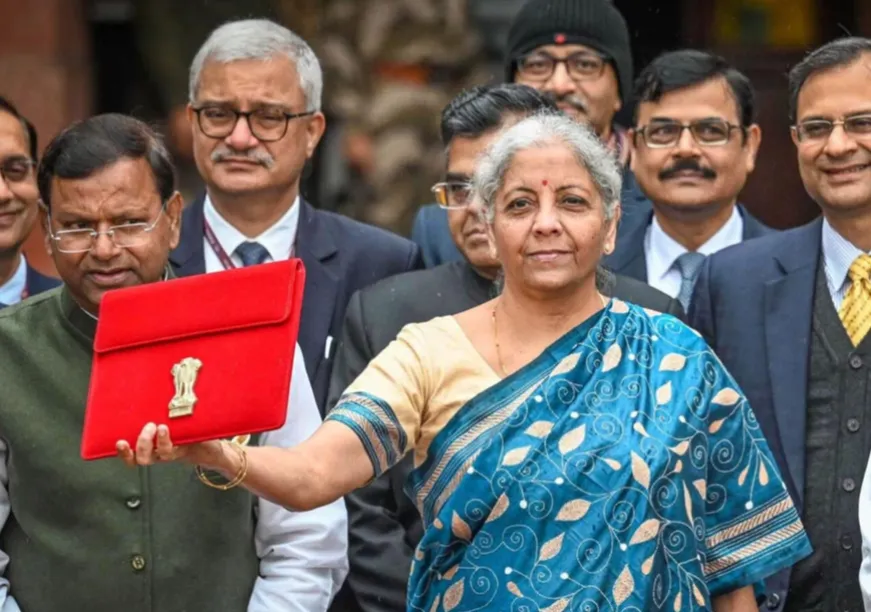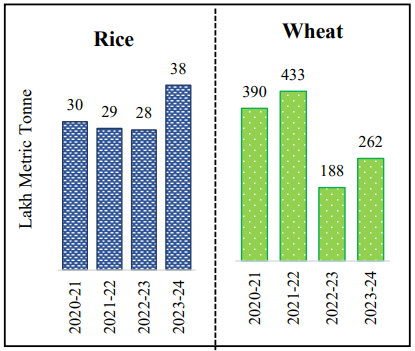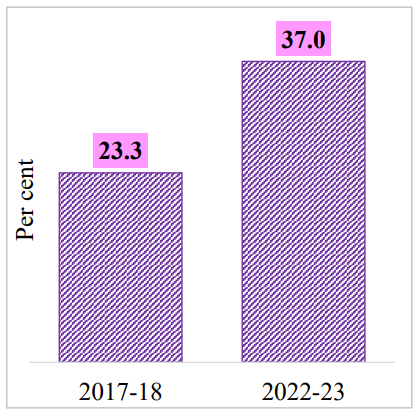-
CENTRES
Progammes & Centres
Location
While the Interim Budget is a temporary plan, the government’s priority and the country’s imperatives remain inclined towards inclusive development

The Union Budget of India lays out the plans of the government for the upcoming fiscal year in terms of expenditure and revenue. While the Budget reflects on the socioeconomic progress made during the previous fiscal year, the primary objective is to convey the government’s financial plans and goals to the People of India. However, an Interim Budget has been presented by Finance Minister Nirmala Sitharaman on 1 February 2024, which is a temporary plan of the government’s fiscal activities, until a new government is elected. This article will look at the major focus areas of the Budget and how the government envisages India’s growth through the empowerment of the poor, the youth, the women, and the farmers.
Prime Minister Narendra Modi launched the “Viksit Bharat@2047: Voice of Youth” on 11 December 2023, to unite the youth and utilise their innovative capacity to bolster India’s development trajectory. This goal of achieving India’s development within a century of its independence was also echoed in the Interim Budget, 2024. The Budget is inclined to balance the trinity of demography, democracy, and diversity—to ride India’s ‘Amrit Kaal’ wave. The government aims to achieve this through increased focus on a people-centric development approach, i.e., sustainable development with the highest possible degree of inclusivity.
The Budget is inclined to balance the trinity of demography, democracy, and diversity—to ride India’s ‘Amrit Kaal’ wave.
The Budget has listed the key methodologies for fostering growth and holistic development of the country. First, the role of infrastructural development of all forms—physical, digital, and social has been emphasised, highlighting the need for systemic reforms to allow for a sustained growth spurt. Second, the role of digital technologies as a means of financial inclusion has been recognised, prioritising the formalisation of Digital Public Infrastructure (DPI). Third, the base broadening effects of the Goods and Services Tax (GST) are to be exploited further to boost the revenue receipts of the government. Fourth, the Gujarat International Finance Tec-City International Financial Services Centre (GIFT IFSC) will be further promoted as a global capital and financial services gateway, creating nearly a million jobs in the economy. Fifth, proactive inflation management will be accorded priority to safeguard consumer interests. Across all these practices, ensuring people-centric inclusive development will be paramount.
While the government’s approach will require policy action in all domains, the Budget delineated a few focus areas which have exhibited great potential in the last decade. For instance, the Direct Benefit Transfer (DBT) Mission which was set up in 2013 to put a check on the delays and fraudulent practices in the disbursement of welfare schemes, has led to a cumulative benefit transfer of INR 34.06 trillion. This has also led to savings of INR 2.7 trillion, marking its significance as a crucial welfare instrument of the government. Further, 250 million people have been pushed out of multidimensional poverty due to the implementation of multiple welfare schemes.
The Direct Benefit Transfer (DBT) Mission which was set up in 2013 to put a check on the delays and fraudulent practices in the disbursement of welfare schemes, has led to a cumulative benefit transfer of INR 34.06 trillion.
The youth have been assigned a consequential role in India’s growth, where it has been stressed that the youth will be the drivers of innovation, which is the key to sustained growth. However, to nudge the youth towards innovative roles, the skill divide in the country needs to be eliminated. While 14 million youth have already been trained under the Skill India Mission, quality education needs to be made a public good. To facilitate that, the outlay for the PM Shri School programme has been raised from INR 40 billion to INR 60.5 billion in the Interim Budget, 2024. Investment in youth is a timely strategy and should be expanded to fully reap the benefits of India’s demographic dividend.
Given India’s dominant position in global agriculture, the steady focus on farmers’ welfare and agricultural productivity is indispensable. The country has seen a rise in the procurement of wheat and rice, which might be due to the export prohibitions placed on these commodities. However, it still implies an expansion of procurement facilities and infrastructure, which translates into greater protection for farmers. The outlay for agriculture and allied activities has been estimated to go up by over INR 60 billion in the fiscal year 2024-25. Besides direct aid to farmers through different schemes, the National Agriculture Market (e-NAM) enabling a centralised agricultural market, will make farmers self-sufficient and reduce their dependence on intermediaries in the value chain.
Figure 1: Procurement of wheat and rice

Source: Budget Highlights
Although female enrolment in higher education has increased by almost 28 percent in the last decade, there is still significant room for improvement. While the female labour force participation rate (LFPR) has increased, it is still significantly lower than the male LFPR. However, Self-Help Groups (SHGs) have played a transformational role in fostering female entrepreneurship, assisting nearly 100,000 women to become ‘lakhpati didis’ (earning 1 lakh per annum per household). The government has revised the target for the number of lakhpati didis from 20 million to 30 million. The government’s approach to enhancing the well-being of women should be noted. Aid in the form of education, employment, and investment opportunities allows women a dignified and self-reliant lifestyle, which fosters an environment with unrestricted upward mobility.
Figure 2: Female Labour Force Participation Rate

Source: Budget Highlights
The government aims to implement strategies which will invigorate growth, while also ensuring its sustainability, based on the principle of “Reform, Perform, and Transform”. The progress and the plans discussed above address various Sustainable Development Goals (SDGs), specifically, SDGs 1 (No poverty), 2 (Zero Hunger), 3 (Good Health and Well-being), 4 (Quality Education), 5 (Gender Equality) and 8 (Decent Work and Economic Growth). While these are the direct target areas of poor-, youth-, women- and farmers-oriented policies, the other SDGs have also been addressed in the goals for Amrit Kaal. For instance, in the energy sector, solarisation of rooftops and free electricity will advance SDGs 7 (Affordable and Clean Energy) and 13 (Climate Action). The tripling of capital expenditure in the last four years, with increased investment in infrastructure and aspirational cities, has strengthened SDGs 9 (Industry, Innovation, and Infrastructure) and 11 (Sustainable Cities and Communities). To promote climate resilient activities, restoration and adaptation measures are being designed, which will directly enhance India’s performance in terms of SDG 13.
The government aims to implement strategies which will invigorate growth, while also ensuring its sustainability, based on the principle of “Reform, Perform, and Transform”.
While the Interim Budget is a temporary plan, the government’s priority and the country’s imperatives remain inclined towards inclusive development. Although no tax revisions have been made to the Finance Bill, abundant measures to reduce inequality are present in the Budget. Finally, the government’s disposition to inculcate an entrepreneurial is noteworthy, when compared to the archaic practice of handing out freebies. Schemes promoting productivity and enterprise are crucial to making both the country and its people ‘Atmanirbhar’ (self-reliant).
Arya Roy Bardhan is a Research Assistant at the Observer Research Foundation
The views expressed above belong to the author(s). ORF research and analyses now available on Telegram! Click here to access our curated content — blogs, longforms and interviews.

Arya Roy Bardhan is a Research Assistant at the Centre for New Economic Diplomacy, Observer Research Foundation. His research interests lie in the fields of ...
Read More +